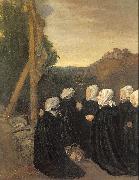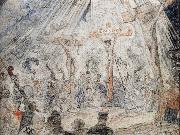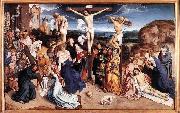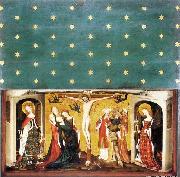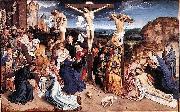Wholesale Oil Painting No Minimum |
|||||||||||
|
|
|||||||||||

|
|||||||||||
|
|
|
||||||||
Legros, AlphonseFrench-born British Painter and Sculptor, 1837-1911 British etcher, painter, sculptor and teacher of French birth. He is said to have been apprenticed at the age of 11 to a sign-painter, at which time he may also have attended classes at the Ecole des Beaux-Arts in Dijon. He was employed as assistant on a decorative scheme in Lyon Cathedral before moving in 1851 to Paris, where he worked initially for the theatre decorator C. A. Cambon (1802-75). He soon became a pupil of Horace Lecoq de Boisbaudran, whose methodical instruction and liberality in fostering individual talent proved of lasting benefit to Legros. In 1855 he enrolled at the Ecole des Beaux-Arts, Paris, attending irregularly until 1857. During this period Legros had a taste for early Netherlandish art and for French Romanticism, which was later superseded by his admiration for Claude, Poussin and Michelangelo. |
||||||||
|
|
||||||||
Calvary
Calvary Painting ID:: 19144 |
1874, Mus??e d'Orsay, Paris 1874, Mus??e d'Orsay, Paris |
|||||||
|
|
||||||||
James EnsorBelgian 1860-1949 Belgian painter, printmaker and draughtsman. No single label adequately describes the visionary work produced by Ensor between 1880 and 1900, his most productive period. His pictures from that time have both Symbolist and Realist aspects, and in spite of his dismissal of the Impressionists as superficial daubers he was profoundly concerned with the effects of light. His imagery and technical procedures anticipated the colouristic brilliance and violent impact of Fauvism and German Expressionism and the psychological fantasies of Surrealism. Ensor most memorable and influential work was almost exclusively produced before 1900, but he was largely unrecognized before the 1920s in his own country. His work was highly influential in Germany, however: Emil Nolde visited him in 1911, and was influenced by his use of masks; Paul Klee mentions him admiringly in his diaries; Erich Heckel came to see him in the middle of the war and painted his portrait (1930; Cologne, Wallraf-Richartz-Mus.); Alfred Kubin owned several of his prints, while Marc Chagall and George Grosz also adapted certain elements from Ensor. All the artists of the Cobra group saw him as a master. He influenced many Belgian artists including Leon Spilliaert, Rik Wouters, Constant Permeke, Frits van den Berghe, Paul Delvaux and Pierre Alechinsky. |
||||||||
|
|
||||||||
|
|
Calvary
Calvary Painting ID:: 37457 |
mk126
1880-86
mk126 1880-86 |
||||||
|
|
||||||||
The Brunswick Monogrammistactive in Antwerp 1588 - 1629 |
||||||||
|
|
||||||||
|
|
Calvary
Calvary Painting ID:: 40989 |
mk159
triptych
mid-16th century
Oil on panel
central part
77x44.5cm
mk159 triptych mid-16th century Oil on panel central part 77x44.5cm |
||||||
|
|
||||||||
|
|
||||||||
|
|
Calvary
Calvary Painting ID:: 63983 |
1500 Oil on oak panel, 142 x 225,5 cm Groeninge Museum, Bruges Borrowings from a variety of artists (Master of Flemalle, Van der Goes, Memling and Derer) are found in the Crucifixion, most likely painted in 1500. (The date on the original frame could be rewritten.) The anonymous Bruges master, referred to on the basis of this work as the 'Master of the Bruges Passion Scenes', combined the three principal elements of the Passion story in a single landscape setting. , Artist: UNKNOWN MASTER, Flemish , Calvary , 1501-1550 , Flemish , painting , religious 1500 Oil on oak panel, 142 x 225,5 cm Groeninge Museum, Bruges Borrowings from a variety of artists (Master of Flemalle, Van der Goes, Memling and Derer) are found in the Crucifixion, most likely painted in 1500. (The date on the original frame could be rewritten.) The anonymous Bruges master, referred to on the basis of this work as the 'Master of the Bruges Passion Scenes', combined the three principal elements of the Passion story in a single landscape setting. , Artist: UNKNOWN MASTER, Flemish , Calvary , 1501-1550 , Flemish , painting , religious |
||||||
|
|
||||||||
|
|
||||||||
|
|
Calvary
Calvary Painting ID:: 64181 |
1400 Oak, 70,5 x 141 cm Groeninge Museum, Bruges The immense growth and renewal of painting as an artistic medium that occurred in the Southern Netherlands from around 1425-30 meant that most existing altarpieces were gradually replaced. Examples of fourteenth- or even early fifteenth-century panel painting are thus extremely scarce. One such work, from around 1400, is the Crucifixion with Saint Catherine and Saint Barbara, also known as the 'Tanners' Crucifixion', because it probably once belonged to the Bruges tanners' guild. It is one of the very few well-preserved examples of local Flemish painting in the Gothic International Style, which conquered Europe with its courtly and artful grace, elegant curves and decorative linearism. Tightly knit groups of figures are arranged on either side of the Cross in matching curved formations. The Virgin and Saint John form the nucleus of the group on the left, while the centurion and high priest do the same on the right. The sky is an unreal, golden plane with decorative motifs in relief. The painting is a 'chest retable', so called because the lid folds up to reveal a blue painted surface showing a geometric, starry sky. It is often held up as an exemplar of Bruges painting before Van Eyck, even though it could equally well have been produced in Brabant. , Artist: UNKNOWN MASTER, Flemish , Calvary , 1401-1450 , Flemish , painting , religious 1400 Oak, 70,5 x 141 cm Groeninge Museum, Bruges The immense growth and renewal of painting as an artistic medium that occurred in the Southern Netherlands from around 1425-30 meant that most existing altarpieces were gradually replaced. Examples of fourteenth- or even early fifteenth-century panel painting are thus extremely scarce. One such work, from around 1400, is the Crucifixion with Saint Catherine and Saint Barbara, also known as the 'Tanners' Crucifixion', because it probably once belonged to the Bruges tanners' guild. It is one of the very few well-preserved examples of local Flemish painting in the Gothic International Style, which conquered Europe with its courtly and artful grace, elegant curves and decorative linearism. Tightly knit groups of figures are arranged on either side of the Cross in matching curved formations. The Virgin and Saint John form the nucleus of the group on the left, while the centurion and high priest do the same on the right. The sky is an unreal, golden plane with decorative motifs in relief. The painting is a 'chest retable', so called because the lid folds up to reveal a blue painted surface showing a geometric, starry sky. It is often held up as an exemplar of Bruges painting before Van Eyck, even though it could equally well have been produced in Brabant. , Artist: UNKNOWN MASTER, Flemish , Calvary , 1401-1450 , Flemish , painting , religious |
||||||
|
|
||||||||
|
|
||||||||
|
|
Calvary
Calvary Painting ID:: 86806 |
Date 1500(1500)
Medium Oil on oak panel
Dimensions Height: 142 cm (55.9 in). Width: 225.5 cm (88.8 in).
cjr Date 1500(1500) Medium Oil on oak panel Dimensions Height: 142 cm (55.9 in). Width: 225.5 cm (88.8 in). cjr |
||||||
|
|
||||||||
|
unknow artist Calvary Date 1500(1500) Medium Oil on oak panel Dimensions Height: 142 cm (55.9 in). Width: 225.5 cm (88.8 in). cjr |
||||||||
|
|
||||||||
|
Prev Next
|
||||||||
|
|
||||||||
|
Related Paintings to unknow artist :. |
||||||||
|
|
||||||||
|
CONTACT US |
